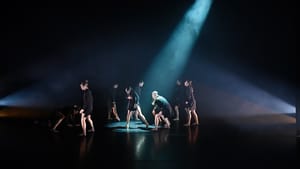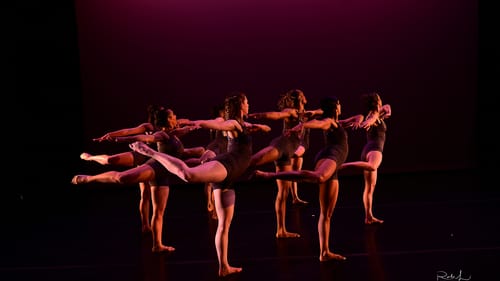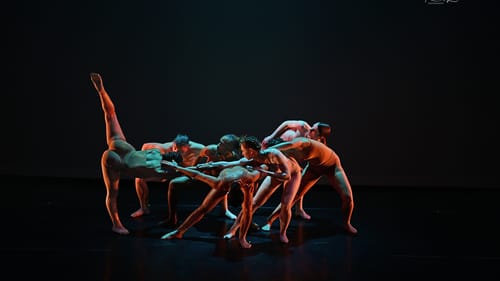Stay in the Loop
BSR publishes on a weekly schedule, with an email newsletter every Wednesday and Thursday morning. There’s no paywall, and subscribing is always free.
Life, breath, and cherry blossoms
Kun-Yang Lin/Dancers presents Breath into Air

A lovely spring day heralded the return of Kun-Yang Lin/Dancers (KYL/D) to FringeArts for its 2024 home season show. Cherry blossom petals swirled through the breeze and on the sidewalks of Old City and, inside the theater, the dancers captured that ethereal grace. The program featured the world premiere of artistic director Kun-Yang Lin’s Breath into Air alongside three shorter dances. This meaningful new work explores grief and loss as opportunities for reflection and gratitude.
Lin conceived and choreographed the dance in collaboration with Evalina Carbonell, Weiwei Ma, and the ensemble. It embodies truths often ignored in American society: death is a part of life, and transitions create room for growth. Our culture does not encourage contemplative pursuits or sharing grief, and we may comprehend these ideas without fully grasping them.
Sharing breath, grief, and recovery
Breath into Air captures the pain of loss, the need to continue, and the healing of community in ways that make these ideas clear and visceral. In doing so, it sets difficult experiences and emotions to movement that finds beauty in them. Before the dance, Lin explained that he created Breath into Air in memory of Marla Soffer—a friend of KYL/D and former board member—to consider breath as a metaphor for life and togetherness, since people sharing spaces breathe the same air.
Yet the work did not ignore the challenges of facing mortality. The dance opened with a person appearing to receive a phone call bearing bad news. Synchronous sections alternated with staccato tableaus in which dancers placed their hands on their hearts and over their faces in gestures of grief. Sometimes they moved convulsively or shook parts of their bodies.
Breath into Air also affirms life in striking and interesting ways. One dancer turned away from the audience to gaze upon a figure who stood in a spotlight near the back of the stage. The rest of the ensemble continued as if they didn’t see the spotlit dancer, and the scene created the impression of a person visited by an otherworldly or divine being. The two regarded one another motionlessly until the first dancer dragged the second closer to the center of the stage, and they embraced.

Two others mimed trying to revive another dancer (Weiwei Ma) before mourning her. When Ma then rose to perform a sequence in which the others assisted her movement, Breath into Air portrayed grief as a physical weight that those who continue living must carry. It also reinforced life continuing after loss: the movement went on after images of death and different scenes arose.
Several parts evoked community and togetherness in grief. Takashi Kanai, Kendall Niblett, and Keila Pérez-Vega shared each other’s weight and assisted one another’s movements. Breath into Air crescendoed with images of support as dancers climbed atop each other, caught one another, and embraced.
A lingering strength
Dancers’ syncopated breathing accompanied original music by Cory Neale and Armand Amar to create a soundscape at once bodily, earthly, and transcendent. At one point, the sound of an exhalation accompanied a segue in the movement. Later, breathing accompanied sounds of waves, water, birds, and church or temple bells to create a soundscape greater than humankind.
A complex and thoughtful work, Breath into Air invites multiple interpretations. Its abstract approach suits the weighty topics it addresses, though this may alienate some viewers. Those open to exploring big ideas in movement will be rewarded with strong performances by a talented ensemble and images that stay with you after the dance ends.
Dragon
Breath into Air was accompanied by excerpts from Lin’s Mandala Project, as well as two dances choreographed by KYL/D dance artists Carbonell and Ma. All were enjoyable, but only Ma’s Dragon (2023) matched the premiere’s power.

Dragon responds to a work of art at Grounds for Sculpture in Hamilton, New Jersey, entitled Dragon’s Shrill in the Cosmic Void (1991) by Yuyu Yang. Because the sculpture is made of stainless steel, viewers seem to become part of the dragon as they approach to see themselves mirrored in it. The dance draws from this as Robert Burden, Abby Donnenfeld, Kanai, Sophie Malin, Niblett, Angelica Nieves-Merced, and Pérez-Vega formed segments of the dragon with their bodies. Ma’s flesh-toned costumes reinforced the connection between humans and the dragon, and the piece ended dramatically with a roar from Burden at the dragon’s head.
Revisiting Mandala Project and Koyl
Mandala Project (excerpts 2011, reimagined 2024) explores in dance the sacred art form of mandalas and their themes of unity and connection. Dancers wore red tunics and pants by Heidi Barr that reflected the Eastern traditions in which mandalas appear, while Tibetan chanting and resonant bells paired with the swirling patterns of Alyssandra Docherty’s lighting design. The dance was enjoyable despite a slower pace and a less fresh and vital feel.
Carbonell’s Koyl (2016) also lacked the punch of Breath into Air and Dragon. It was well danced by Carbonell and Ma, who wore long, sheer skirts that elevated the grace and drama of their movement. Yet the feminine dance contrasted with the mournful music by Sylvain Chauveau and Ljova and the Kontraband. The “coiled inner violence of the feminine experience” described in the program notes was difficult to detect.
Bookended by Dragon and Breath into Air, KYL/D’s spring performance was as beautiful and kinetic as the cherry blossoms outside. Altogether, the program reflected the company’s continuous growth and the strength of the ensemble. Seeing Mandala Project alongside the world premiere highlighted Lin’s development as a choreographer and artistic director. Meanwhile, the works by Carbonell and Ma celebrated them as artists in their own right.
What, When, Where
Breath into Air. Choreography by Kun-Yang Lin, Evalina Carbonell, and Weiwei Ma. Kun-Yang/Lin Dancers. $25-$40. April 19-20, 2024, at FringeArts, 140 N Columbus Boulevard, Philadelphia. kyld.org.
Accessibility
FringeArts is a wheelchair-accessible venue with gender-neutral restrooms. Visit its accessibility services page for more information.
Sign up for our newsletter
All of the week's new articles, all in one place. Sign up for the free weekly BSR newsletters, and don't miss a conversation.

 Melissa Strong
Melissa Strong